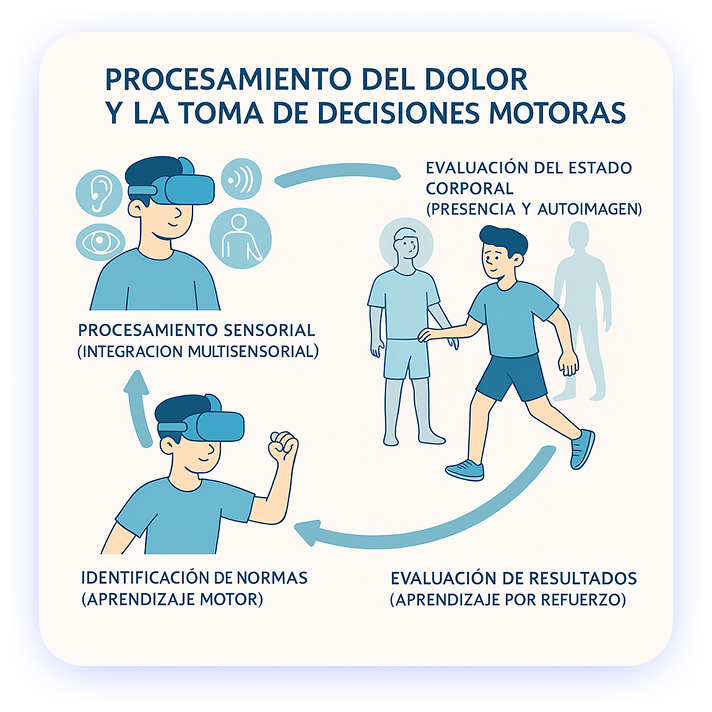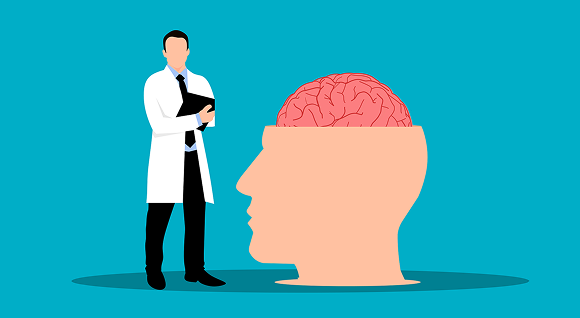Virtual Reality and pain management in neurological patients.
Dynamics VR – 07/21/2025
Table of Contents
- 1. Frequency of pain in neurological conditions
- 2. Pain processing and motor decision making.
- 3. How can Dynamics VR help?
Frequency of pain in neurological conditions
Pain is one of the most prevalent and debilitating sequelae in neurological disorders, significantly affecting patients’ quality of life:
- Stroke: Pain occurs in a wide range from 19% to 74% of cases, with the shoulder being the most frequent location, with an estimated prevalence between 11% and 40% (Kim, 2009).
- CRANEOENCEPHALIC TRAUMATISM (CTE): chronic pain affects 51.5% of patients, while acute pain is common in the first weeks after trauma, related to tissue damage (Irvine & Clark, 2018).
- PATKINSON: Up to 85% of patients report some type of pain, which tends to worsen with disease progression and generates considerable economic impact (Naisby et al., 2021).
- ALZHEIMER: The prevalence of chronic pain is around 45.8%, although it is often underdiagnosed due to the difficulty of patients to report it. In addition, neurological alterations similar to idiopathic chronic pain have been observed, such as dysfunctions in the noradrenergic system, microglial activation, and increased neuroinflammation in the frontal cortex (Cao et al., 2019).
Pain processing and motor decision making.
Active and effective rehabilitation requires understanding how chronic pain influences motor behavior and decision-making. According to the dynamic model proposed by Guerra-Armas et al. (2023), immersive interventions with Virtual Reality can positively influence the following stages of pain processing:
1. Sensory processing (multisensory integration)
In many neurological conditions, the integration of sensory stimuli is impaired. VR allows modulating the relevance of these stimuli (visual, auditory, haptic), and adapting them to the patient’s sensory profile, facilitating a more coherent and effective experience (Kamari et al., 2024; Ferrer-Costa et al., 2025).
2. Evaluation of body condition (presence and self-image).
Immersion in virtual environments makes it possible to modify the perception of the body and the environment by creating body illusions (such as full-body avatars), taking advantage of the functioning of mirror neurons to influence pain perception (Drakenberg et al., 2023).
3. Identification of norms (motor learning)
The congruence between the user’s movements and their avatar facilitates a new motor learning process, reinforcing functional patterns that help reduce pain-related compensatory behaviors.
4. Evaluation of results (learning by reinforcement)
By changing the interpretation of painful stimuli, the patient can experience new ways of moving in different environments. Repetitive practice of functional tasks in these virtual scenarios facilitates neuromotor reorganization and movement control, with both physical and cognitive benefits.

How can Dynamics VR help?
The Dynamics VR solution integrates immersive environments specifically designed for pain management in neurological patients, combining repetitive functional tasks, real-time visual feedback and cognitive strategies adapted to the clinical profile.
Thanks to its interactive scenarios and the possibility of customizing exercises according to the patient’s functional and sensory level, Dynamics promotes motor activation without generating threat, thus reducing the vicious pain-fear-inactivity cycle. It also allows the therapist to monitor the patient’s response in real time, adjust the stimuli and promote positive motor learning.
Ultimately, Dynamics VR not only offers an innovative innovative therapeutic toolbut also an effective and motivating way to reduce pain and improve functionality in complex neurological populations.
You may be interested in...

By Dynamics VR l July 17, 2025.
Evidence of Virtual Reality in Acquired Brain Injury
Acquired Brain Injury (ABI) is an injury that appears in the brain after birth, and is not hereditary, congenital or degenerative. It can arise traumatically, as in traffic accidents or falls…

By Dynamics VR l July 21, 2025.
Evidence of Virtual Reality in Non-Acquired Brain Injury
Non-acquired brain damage refers to those neurological alterations present from birth or developed throughout life as a consequence of genetic processes or diseases….

